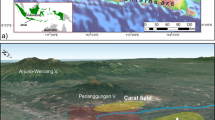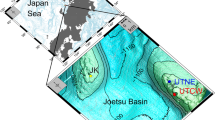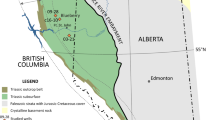Abstract
Oil is generally thought to be geologically young, as it is thermodynamically unstable when subjected to elevated temperatures over long periods in open systems1,2. Indeed, almost all petroleum production comes from rocks younger than 400 million years (ref. 3). Although the oldest known oil occurs in rocks 1,650 Myr old4, suitable source rocks were abundant in older geological successions5 and circumstantial evidence suggests that some of these generated hydrocarbons early in their history6. Here, we report the discovery of oil preserved in fluid inclusions in sandstones dating back ∼3,000 Myr. Most inclusions lie within healed microfractures confined to individual detrital quartz grains, indicating that their oil was emplaced before Archaean or Palaeoproterozoic metamorphism sealed all voids and thus came from older (in some cases Archaean) sources. The fluid inclusions apparently acted as inert pressure vessels that protected the oil from subsequent degradation by circulating fluids and mineral catalysts. Because of its great age, this oil can potentially yield valuable information about the size and diversity of the early biosphere, particularly if it contains molecular fossils (biomarkers) of the primordial organisms from which it was derived.
This is a preview of subscription content, access via your institution
Access options
Subscribe to this journal
Receive 51 print issues and online access
$199.00 per year
only $3.90 per issue
Buy this article
- Purchase on Springer Link
- Instant access to full article PDF
Prices may be subject to local taxes which are calculated during checkout



Similar content being viewed by others
References
Quigley, T. M. & Mackenzie, A. S. The temperatures of oil and gas formation in the subsurface. Nature 333, 549–553 (1988).
Mango, F. D. The stability of hydrocarbons under the time-temperature conditions of petroleum genesis. Nature 352, 146–148 (1991).
Bois, C., Bouche, P. & Pelet, R. Global geologic history and distribution of hydrocarbon reserves. Bull. Am. Assoc. Petrol. Geol. 66, 1248–1270 (1982).
Jackson, M. J., Powell, T. G., Summons, R. E. & Sweet, I. P. Hydrocarbon shows and petroleum source rocks in sediments as old as 1.7 × 109 years. Nature 322, 727–729 (1986).
McKirdy, D. M. & Imbus, S. W. in Early Organic Evolution: Implications for Mineral and Energy Resources (eds Schidlowski, M. et al.) 176–192 (Springer, Berlin, 1992).
Buick, R., Rasmussen, B. & Krapez, B. Archean oil: evidence for extensive hydrocarbon generation and migration 2.5–3.6 Ga. Bull. Am. Assoc. Petrol. Geol. 82, 50–69 (1998).
Mossman, D. J., Nagy, B. & Davis, D. W. Hydrothermal alteration of organic matter in uranium ores, Elliot Lake, Canada: implications for selected organic-rich deposits. Geochim. Cosmochim. Acta 57, 3521–3259 (1993).
Rasmussen, B., Glover, J. E. & Alexander, R. Hydrocarbon rims on monazite in Permian-Triassic arenites, northern Perth Basin, Western Australia: pointers to the former presence of oil. Geology 17, 115–118 (1989).
Rasmussen, B. Fluorescent growth bands in irradiated-bitumen nodules: evidence of episodic hydrocarbon migration. Bull. Am. Assoc. Petrol. Geol. 81, 17–25 (1997).
Roedder, E. Fluid Inclusions (Mineral. Soc. Am., Washington DC, 1984).
Pironon, J. & Pradier, B. Ultraviolet-fluorescence alteration of hydrocarbon fluid inclusions. Org. Geochem. 18, 501–509 (1992).
Bjørlykke, K. & Egeberg, P. K. Quartz cementation in sedimentary basins. Bull. Am. Assoc. Petrol. Geol. 77, 1539–1548 (1993).
Zhang, J., Wong, T-F. & Davis, D. M. Micromechanics of pressure-induced grain crushing in porous rocks. J. Geophys. Res. 95, 341–352 (1990).
Brantley, S. L., Evans, B., Hickman, S. L. & Crerar, D. A. Healing of microcracks in quartz: implications for fluid flow. Geology 18, 136–139 (1990).
Laubach, S. E. Amethod to detect natural fracture strike in sandstones. Bull. Am. Assoc. Petrol. Geol. 81, 604–623 (1997).
Groshong, R. H. Low-temperature deformation mechanisms and their interpretation. Geol. Soc. Am. Bull. 100, 1329–1360 (1988).
Robb, L. J., Charlesworth, E. G., Drennan, G. R., Gibson, R. L. & Tongu, E. L. Tectono-metamorphic setting and paragenetic sequence of Au-U mineralisation in the Archaean Witwatersrand Basin, South Africa. Aust. J. Earth Sci. 44, 353–371 (1997).
Hobson, G. D. & Tiratsoo, E. N. Introduction to Petroleum Geology (Gulf Publ. Co., Houston, 1981).
Strauss, H. & Moore, T. B. in The Proterozoic Biosphere: A Multidisciplinary Study (eds Schopf, J. W. & Klein, C.) 709–798 (Cambridge Univ. Press, 1992).
Ungerer, P. State of the art of research in kinetic modelling of oil formation and expulsion. Org. Geochem. 16, 1–25 (1990).
Price, L. C. Thermal stability of hydrocarbons in nature: limits, evidence, characteristics, and possible controls. Geochim. Cosmochim. Acta 57, 3261–3280 (1993).
Hoffmann, C. F., Henley, R. W., Higgins, N. C., Solomon, M. & Summons, R. E. Biogenic hydrocarbons in fluid inclusions from the Aberfoyle tin-tungsten deposit, Tasmania, Australia. Chem. Geol. 70, 287–299 (1988).
Newell, K. D., Burruss, R. C. & Palacas, J. G. Thermal maturation and organic richness of potential petroleum source rocks in Proterozoic Rice Formation, North American Mid-Continent rift system, northeastern Kansas. Bull. Am. Assoc. Petrol. Geol. 77, 1922–1941 (1993).
George, S. C. & Jardine, D. R. Ketones in a Proterozoic dolerite sill. Org. Geochem. 21, 829–839 (1994).
Hayes, J. M. in Earth's Earliest Biosphere: Its Origin and Evolution (ed. Schopf, J. W.) 291–301 (Princeton Univ. Press, 1983).
Knoll, A. H. & Holland, H. D. in Effects of Past Global Change on Life (ed. Stanley, S.) 1–17 (National Academy of Science Press, Washington DC, 1995).
Hayes, J. M. in Early Life on Earth: Nobel Symposium No. 84 (ed. Bengtson, S.) 220–236 (Columbia Univ. Press, New York, 1994).
Buick, R. et al. Record of emergent continental crust ∼3.5 billion years ago in the Pilbara Craton of Australia. Nature 375, 574–577 (1995).
Falkowski, P. G. Evolution of the nitrogen cycle and its influence on the biological sequestration of CO2in the ocean. Nature 387, 272–275 (1997).
Des Marais, D. J., Strauss, H., Summons, R. E. & Hayes, J. M. Carbon isotope evidence for the stepwise oxidation of the Proterozoic environment. Nature 359, 605–609 (1992).
Summons, R. E. & Walter, M. R. Molecular fossils and microfossils of prokaryotes and protists from Proterozoic sediments. Am. J. Sci. 290-A, 212–244 (1990).
Martin, D. McB., Clendenin, C. W., Krapez, B. & McNaughton, N. J. Tectonic and geochronological constraints on late Archaean and Palaeoproterozoic stratigraphic correlation within and between the Kaapvaal and Pilbara Cratons. J. Geol. Soc. Lond. 155, 311–322 (1998).
Acknowledgements
We thank G. Ellis, T. S. Blake and B. Krapez for samples, M. Kassis for sample preparation, T. Vassallo for FTIR interpretation and P. J. Eadington, R. D. Müller, L. C. Ivany and B.Krapez for discussions and criticism. This work was supported by an ARC grant to R.B. and an ARC postdoctoral fellowship to B.R.
Author information
Authors and Affiliations
Corresponding author
Rights and permissions
About this article
Cite this article
Dutkiewicz, A., Rasmussen, B. & Buick, R. Oil preserved in fluid inclusions in Archaean sandstones. Nature 395, 885–888 (1998). https://doi.org/10.1038/27644
Received:
Accepted:
Issue Date:
DOI: https://doi.org/10.1038/27644
This article is cited by
-
Ingredients for microbial life preserved in 3.5 billion-year-old fluid inclusions
Nature Communications (2021)
-
Water near its Supercritical Point and at Alkaline pH for the Production of Ferric Oxides and Silicates in Anoxic Conditions. A New Hypothesis for the Synthesis of Minerals Observed in Banded Iron Formations and for the Related Geobiotropic Chemistry inside Fluid Inclusions
Origins of Life and Evolution of Biospheres (2018)
-
Oil cracking of deep petroleum in Minfeng sag in north Dongying depression, Bohai Bay basin, China: Evidence from natural fluid inclusions
Journal of Earth Science (2010)
-
Oil-bearing fluid inclusions from the Palaeoproterozoic: A review of biogeochemical results from time-capsules >2.0 Ga old
Science in China Series D: Earth Sciences (2009)
-
Molecular Biosignatures
Space Science Reviews (2008)
Comments
By submitting a comment you agree to abide by our Terms and Community Guidelines. If you find something abusive or that does not comply with our terms or guidelines please flag it as inappropriate.



